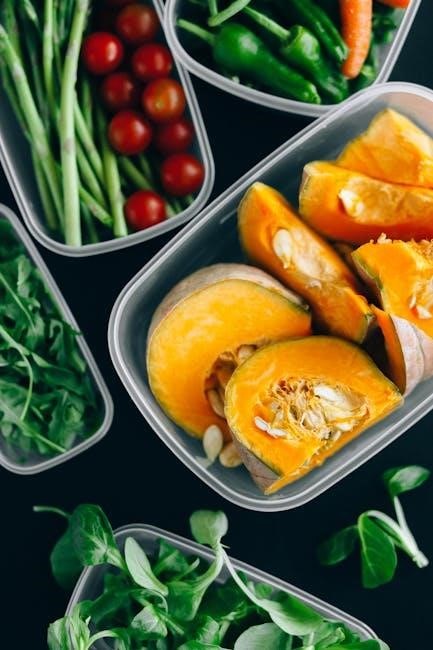Acid reflux‚ also known as GERD‚ is a chronic condition where stomach acid flows back into the esophagus‚ causing discomfort. Diet plays a crucial role in managing symptoms. Certain foods like fatty‚ citrus‚ or spicy items can trigger acid reflux‚ while others may help alleviate it. Understanding dietary choices is essential for controlling this condition effectively.
Understanding Acid Reflux and GERD

Gastroesophageal reflux disease (GERD) is a chronic condition where stomach acid frequently flows back into the esophagus‚ causing irritation and discomfort. Acid reflux occurs when the lower esophageal sphincter (LES)‚ which acts as a barrier between the esophagus and stomach‚ weakens or relaxes abnormally. This allows stomach acid to move upward‚ leading to symptoms like heartburn‚ chest pain‚ and difficulty swallowing. Over time‚ untreated GERD can damage the esophageal lining and increase the risk of complications. While occasional acid reflux is common‚ GERD is diagnosed when symptoms occur at least twice a week. Lifestyle factors‚ diet‚ and certain foods can trigger or worsen symptoms‚ making it essential to identify and manage these triggers effectively.
The Role of Diet in Managing Acid Reflux
Diet plays a pivotal role in managing acid reflux‚ as certain foods can trigger or alleviate symptoms. Foods that relax the lower esophageal sphincter‚ delay stomach emptying‚ or increase stomach acid production often worsen reflux. For instance‚ fatty or fried foods slow digestion‚ allowing acid to rise. Similarly‚ acidic foods like citrus or tomatoes can irritate the esophagus. On the other hand‚ low-acid‚ high-fiber foods such as vegetables and whole grains can help reduce symptoms. A tailored diet plan‚ avoiding triggers and incorporating beneficial foods‚ is essential for controlling acid reflux effectively. By understanding how different foods affect the body‚ individuals can make informed choices to manage their condition and improve overall well-being.

Common Foods to Avoid
Fatty‚ fried‚ citrus‚ tomato-based‚ chocolate‚ spicy‚ caffeine‚ carbonated‚ alcoholic‚ minty‚ processed‚ and high-sodium foods often trigger acid reflux by relaxing the esophageal sphincter or increasing acid production.
Fatty and Fried Foods
Fatty and fried foods are among the top triggers for acid reflux. They slow down digestion‚ allowing stomach acid to linger and potentially reflux into the esophagus. High-fat foods‚ such as fried foods‚ full-fat dairy‚ and processed meats‚ take longer to digest‚ increasing pressure on the lower esophageal sphincter (LES). This delayed digestion can cause the LES to relax improperly‚ leading to acid backup. Fried foods like french fries‚ fried chicken‚ and doughnuts are particularly problematic due to their high fat content. Reducing or avoiding these foods can significantly help manage acid reflux symptoms. Opting for lean proteins‚ baked or grilled options‚ and low-fat alternatives is a healthier choice for those with GERD.
Citrus Fruits and Juices
Citrus fruits and juices‚ such as oranges‚ grapefruits‚ and lemons‚ are highly acidic and can trigger acid reflux. The high acidity relaxes the lower esophageal sphincter (LES)‚ allowing stomach acid to flow back into the esophagus. This can lead to heartburn and discomfort. Even though these fruits are nutritious‚ their acidity makes them problematic for those with GERD. Consuming citrus fruits or juices‚ especially on an empty stomach‚ can exacerbate symptoms. To manage acid reflux‚ it’s advisable to limit or avoid citrus products and opt for non-acidic fruits like bananas or melons instead.
Tomatoes and Tomato-Based Products
Tomatoes and tomato-based products‚ such as marinara sauce‚ tomato soups‚ and ketchup‚ are known to trigger acid reflux due to their high acidity. Tomatoes contain malic acid and citric acid‚ which can relax the lower esophageal sphincter (LES)‚ allowing stomach acid to flow back into the esophagus. Additionally‚ processed tomato products often include added sugars and preservatives‚ which can further irritate the digestive system. For individuals with GERD‚ it’s recommended to limit or avoid tomato-based dishes and opt for low-acid alternatives‚ such as green vegetables or non-acidic sauces‚ to help reduce symptoms and prevent discomfort.
Chocolate
Chocolate is a common trigger for acid reflux due to its high fat and cocoa content. The cocoa in chocolate contains compounds like theobromine‚ which can relax the lower esophageal sphincter (LES)‚ making it easier for stomach acid to rise into the esophagus. Dark chocolate and milk chocolate both contribute to symptoms‚ though dark chocolate‚ with its higher cocoa content‚ may be more problematic. Additionally‚ chocolate often contains added sugars and fats‚ which can slow digestion and worsen reflux. People with GERD are advised to limit or avoid chocolate and opt for low-fat‚ non-chocolate alternatives to reduce discomfort and prevent heartburn episodes.
Spicy Foods
Spicy foods are known to trigger acid reflux symptoms in many individuals. The capsaicin present in chili peppers can irritate the esophagus and stimulate the production of stomach acid‚ leading to heartburn. Additionally‚ spicy foods may weaken the lower esophageal sphincter‚ allowing acid to flow back into the esophagus more easily. While some people may tolerate mild spices without issues‚ others experience significant discomfort after consuming spicy dishes. To manage acid reflux‚ it is often recommended to avoid or reduce the intake of spicy foods‚ especially those containing hot peppers or heavy spices. Opting for milder flavors and monitoring symptoms can help in identifying personal triggers and managing the condition more effectively.
Caffeine and Coffee

Caffeine and coffee are common triggers for acid reflux symptoms. Caffeine can relax the lower esophageal sphincter‚ allowing stomach acid to flow back into the esophagus. Coffee‚ in particular‚ contains compounds that may irritate the stomach lining and increase acid production. Even decaffeinated coffee can cause issues for some individuals. The acidity of coffee‚ rather than just the caffeine content‚ plays a significant role in triggering reflux. For those who enjoy coffee‚ it is often recommended to drink it in moderation‚ avoid it on an empty stomach‚ or switch to lower-acidity coffee blends. Monitoring symptoms after consumption can help determine if coffee or caffeine should be avoided entirely to manage acid reflux effectively.
Carbonated Beverages
Carbonated beverages‚ such as sodas‚ sparkling water‚ and energy drinks‚ are known to trigger acid reflux symptoms. The carbonation increases stomach pressure‚ leading to belching‚ which can push stomach acid into the esophagus. Additionally‚ these drinks often contain caffeine or artificial flavors that can further irritate the stomach lining. Even non-caffeinated carbonated beverages can cause discomfort‚ as the fizz can disrupt the lower esophageal sphincter. For individuals with GERD‚ it is advisable to limit or avoid carbonated drinks altogether. Opting for still water‚ herbal teas‚ or low-acid juices can help reduce symptoms and support a reflux-friendly diet. Avoiding carbonated beverages is a simple yet effective step in managing acid reflux and preventing discomfort.
Alcohol
Alcohol is a common trigger for acid reflux‚ as it relaxes the lower esophageal sphincter‚ allowing stomach acid to flow back into the esophagus. Beer‚ wine‚ and spirits can all contribute to symptoms. Alcohol also irritates the stomach lining‚ increasing inflammation and discomfort. Additionally‚ it can slow digestion‚ prolonging the time acid stays in the stomach. While some people may tolerate small amounts‚ others find complete avoidance necessary. Moderation is key‚ but for severe GERD‚ eliminating alcohol entirely may be the best choice. Pairing alcohol with fatty or spicy foods exacerbates symptoms further. To manage reflux‚ consider limiting alcohol intake or switching to non-alcoholic alternatives to reduce discomfort and support a healthier digestive system.
Mint and Peppermint
Mint and peppermint are well-known for their ability to soothe digestion‚ but they can worsen acid reflux symptoms. Peppermint‚ in particular‚ relaxes the lower esophageal sphincter‚ making it easier for stomach acid to flow back into the esophagus. While mint teas or candies may provide temporary relief from bloating‚ the long-term effect can be detrimental for GERD sufferers. Even though mint is not acidic itself‚ its impact on the sphincter muscles can lead to increased heartburn and discomfort. Therefore‚ individuals with frequent acid reflux episodes should consider avoiding peppermint and other mint varieties to prevent symptom flare-ups and maintain better control over their condition.
Processed Foods
Processed foods are often high in unhealthy fats‚ sodium‚ and preservatives‚ which can exacerbate acid reflux symptoms. These foods tend to slow digestion‚ putting additional pressure on the lower esophageal sphincter and increasing the likelihood of acid backflow. Examples include packaged snacks‚ frozen meals‚ and processed meats. Many processed foods are also high in sugar and low in fiber‚ contributing to poor digestion and discomfort. Overconsumption of these items can lead to weight gain‚ further aggravating GERD symptoms. To manage acid reflux effectively‚ it is advisable to limit processed foods and opt for whole‚ nutrient-rich alternatives. Moderation is key‚ as even small portions can trigger discomfort in sensitive individuals.
High-Sodium Foods
High-sodium foods can contribute to acid reflux by causing stomach bloating and discomfort‚ which may worsen symptoms. Excessive sodium intake can lead to water retention‚ increasing pressure on the stomach and lower esophageal sphincter. Processed and packaged foods‚ such as canned goods‚ soups‚ and restaurant meals‚ are typically high in sodium. Reducing sodium intake can help alleviate bloating and discomfort associated with acid reflux. Opting for low-sodium alternatives and seasoning meals with herbs instead of salt can be beneficial. It is important to check food labels and limit daily sodium consumption to manage symptoms effectively. Balancing sodium intake is a practical step in maintaining a GERD-friendly diet.

Foods That Help Manage Acid Reflux
Certain foods can alleviate acid reflux symptoms by stabilizing digestion and reducing stomach acid production. Non-citrus fruits‚ low-acid vegetables‚ lean proteins‚ and whole grains are beneficial options.

Non-Citrus Fruits
Non-citrus fruits are an excellent choice for managing acid reflux due to their low acidity and soothing effects on the digestive system. Bananas‚ melons‚ and apples are particularly beneficial as they are gentle on the esophagus and help neutralize stomach acid. These fruits are rich in fiber‚ which promotes digestion and reduces symptoms. Incorporating non-citrus fruits into meals can provide essential nutrients while minimizing discomfort. They are also less likely to trigger the relaxation of the lower esophageal sphincter‚ making them a safe and healthy option for those with GERD.
Low-Acid Vegetables
Low-acid vegetables are highly recommended for managing acid reflux‚ as they are gentle on the esophagus and stomach lining. Vegetables like broccoli‚ asparagus‚ and green beans are excellent choices due to their low acidity and high fiber content‚ which aids digestion. These vegetables help reduce inflammation and prevent the relaxation of the lower esophageal sphincter‚ minimizing acid reflux symptoms; Additionally‚ they are rich in essential nutrients and antioxidants‚ promoting overall health. Incorporating low-acid vegetables into meals can provide relief from heartburn and discomfort. They are versatile and can be prepared in various ways‚ making them a practical addition to a GERD-friendly diet.
Lean Proteins
Lean proteins are an excellent choice for managing acid reflux‚ as they are less likely to trigger symptoms compared to fatty or processed meats. Opting for lean meats like poultry‚ fish‚ or plant-based proteins such as tofu and legumes can help reduce discomfort. These proteins are easier to digest and do not put excessive pressure on the lower esophageal sphincter‚ minimizing the risk of acid reflux. Additionally‚ lean proteins promote a balanced diet and support overall digestive health. Pairing them with non-acidic vegetables can further enhance their benefits‚ creating a meal that is both nourishing and gentle on the stomach.
Whole Grains
Whole grains are a beneficial addition to a GERD-friendly diet due to their high fiber content‚ which can help reduce acid reflux symptoms. Foods like oatmeal‚ brown rice‚ and whole-grain bread are excellent choices. They aid in digestion and absorbs excess stomach acid‚ minimizing discomfort. Unlike refined grains‚ whole grains are less likely to trigger reflux because they are not processed and retain their natural nutrients. Incorporating whole grains into meals helps create a balanced diet that supports overall digestive health. Pairing them with lean proteins or low-acid vegetables can further enhance their benefits. Opting for whole grains over processed or high-fat alternatives is a practical step in managing acid reflux effectively.
Lifestyle Tips for Acid Reflux Management
Maintaining a healthy weight‚ eating smaller meals‚ and avoiding tight clothing can reduce acid reflux symptoms. Elevating the head during sleep and avoiding late-night eating also helps.
Portion Control and Meal Timing

Managing acid reflux effectively involves practicing portion control and mindful meal timing. Eating smaller‚ more frequent meals throughout the day can reduce stomach pressure and prevent acid from flowing back into the esophagus. Avoiding heavy meals close to bedtime is crucial‚ as lying down immediately after eating exacerbates symptoms. Allow at least 2-3 hours after eating before reclining or sleeping. Additionally‚ spreading meals evenly helps maintain stable digestion and reduces the likelihood of reflux episodes. By focusing on smaller portions and strategic meal scheduling‚ individuals can significantly alleviate acid reflux discomfort and improve overall digestive health. This approach complements dietary adjustments and supports long-term symptom management.
Weight Management
Maintaining a healthy weight is a critical component in managing acid reflux. Excess body weight‚ particularly around the abdominal area‚ can increase intra-abdominal pressure‚ pushing stomach contents upward and causing acid reflux. Studies suggest that even a modest weight loss of 5-10% can significantly reduce symptoms. Incorporating regular physical activity‚ such as walking or low-impact exercises‚ helps burn calories and strengthen core muscles‚ which support the lower esophageal sphincter. Combining a balanced diet with portion control and lifestyle changes can lead to sustainable weight management‚ thereby alleviating acid reflux symptoms. Monitoring progress and setting realistic goals ensures long-term success in both weight loss and symptom relief.

Creating a GERD-Friendly Diet Plan
Developing a GERD-friendly diet involves identifying trigger foods‚ tracking symptoms‚ and gradually implementing changes. Focus on low-acid‚ high-fiber foods and portion control for sustainable relief.
Practical Steps for Implementing Dietary Changes
Start by identifying and eliminating trigger foods like citrus fruits‚ tomatoes‚ chocolate‚ and spicy or fatty items. Keep a food diary to track symptoms and reactions. Gradually incorporate low-acid‚ high-fiber foods such as non-citrus fruits‚ lean proteins‚ and whole grains. Opt for smaller‚ more frequent meals to avoid overloading the stomach. Avoid lying down after eating and elevate the head of your bed for better digestion. Stay hydrated with water and herbal teas‚ avoiding carbonated beverages. Consider consulting a dietitian for a personalized meal plan. Over time‚ these changes can significantly reduce acid reflux symptoms and improve overall well-being.
Managing acid reflux effectively requires a tailored dietary approach focused on avoiding trigger foods and incorporating beneficial options. By eliminating fatty‚ citrus‚ spicy‚ and high-acid foods‚ individuals can significantly reduce symptoms. Incorporating lean proteins‚ non-citrus fruits‚ and whole grains supports a GERD-friendly lifestyle. Practical steps like portion control‚ meal timing‚ and weight management further enhance symptom relief. Patience and consistency are key‚ as dietary changes may take time to yield results. With the right adjustments and professional guidance‚ many people find long-term relief from acid reflux‚ improving their overall quality of life. A personalized approach ensures sustainable wellness for those navigating this condition.